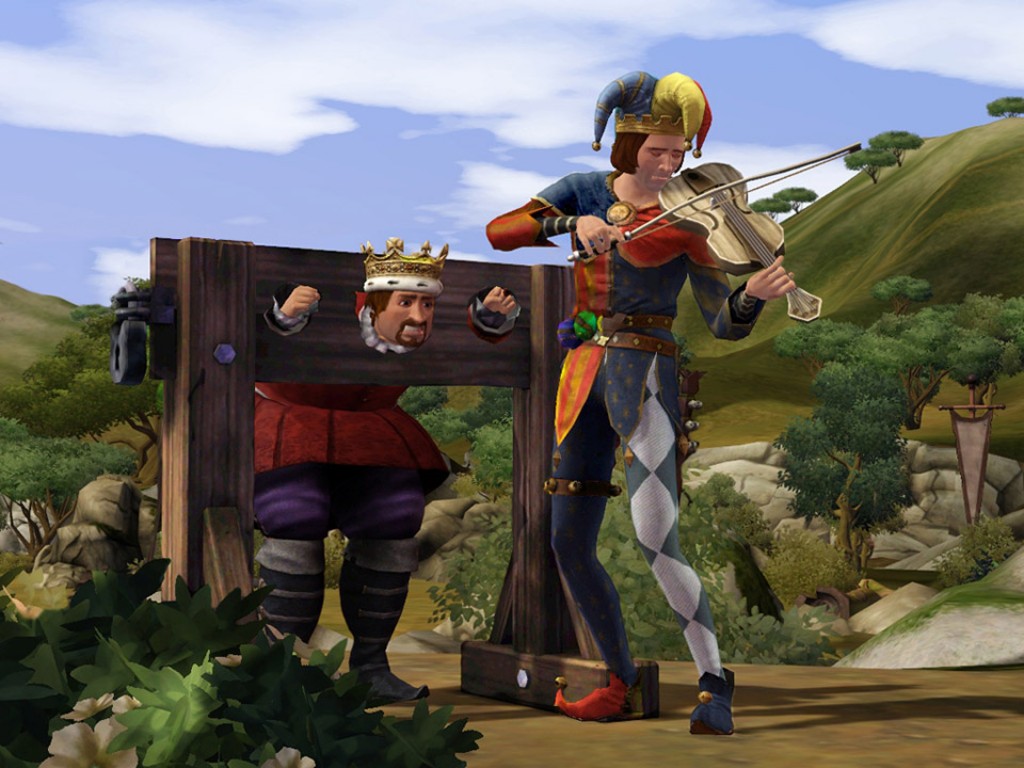The Sims: Medieval
PCOn its release The Sims Medieval elbowed its way past Crisis 2 to head straight to the top of the PC charts, underlining the enduring popularity of The Sims in all its incarnations. But does it deliver?
The Sims has come a long way since it first appeared on our PC screens back in 2000. Back then we couldn’t get up close and personal, the simulated people’s actions and interactions were fairly limited, and we couldn’t leave the house. These things changed gradually with the various expansion packs and with subsequent iterations, The Sims 2 and (most recently) The Sims 3. And to add a little more interest, those canny folk at EA expanded the franchise to allow us to play through a number of Sims Stories where, for example, we could play as a castaway on a strange tropical island, or as an animal breeder keen to enter their mutt into a show. What could possibly be left for The Sims? Where was left to go? Back in time, that’s where.
The Sims Medieval isn’t like all those other Sims games – at least, not entirely. It is a clever blend of what’s great about the Sims Stories genre, The Sims 3 and Sim City Societies, with a little bit of Black & White thrown in for good measure (all published by EA, take note). And what’s not to like about a game that starts with a story told by the venerable Sir Patrick Stewart?
When you start to play, you are provided with a brand new kingdom which you get to name. At the beginning only the great hall is built, which is the stage for the opening quests where you play as the monarch. As you progress through the game you can play as an additional nine types of hero, including a knight, merchant, bard, Jacoban or Peteran priest, spy, wizard, physician and blacksmith, each of which is associated with different specialised abilities and quests. In addition, you are present in the game as The Watcher, a kind of a deity (but not quite in the same way as in Black & White) that your sims may only be aware of if they are of religious bent. You can roam freely about the land, but there are also a few useful locations that you can take a shortcut to visit, including the town square, pit of judgement (where monarchs send uncitizenly sims either to be devoured by the beast or pelted with vegetable matter in the stocks), docks (from which to take a boat for a voyage), forest (good for hunting) and village (handy for stocking up on medieval groceries at the shoppe).

I take it back! This kingdom's got talent!
This is a much more complex game than other Sims Stories offerings. In those, you simply play your way through the stories, following the series of actions that the game tells you that you need to take in order to progress with the overall narrative (making sure your sim is fed and watered and has slept enough, and all the other little things those demanding tykes require you to keep an eye on) after which – once the goal has been achieved – you can play freely in that world with those characters. In contrast, with The Sims Medieval there are several different levels of gameplay and no completely fixed narrative.
As The Watcher, you can pursue 12 different ambitions for your kingdom – one at a time of course – and as you work through them, you level up from the initial ‘Peepsmith’ you start out as; this has obvious similarities to the recent Sim City Societies. The gameplay centres on quests, which are very similar to the kinds of stories you would play through in predecessor Sim Stories games, although there are more opportunities to choose where to steer the story at various forks in the narrative. The more quests you play, the more ‘resource points’ you get, which you can spend on building particular kinds of buildings with which particular kinds of heroes are associated, thus opening up new quests. In addition, each quest you successfully complete provides you with a contribution to the four ‘aspects’ of your kingdom – wellbeing, security, culture and knowledge – which contributes both to the completion of the particular ‘ambition’ you have chosen to pursue with your kingdom, and to your levelling up as The Watcher. Complicated, huh?
Even though it’s a much more interesting and complex game, there are some small pockets of disappointment. The way you build things has more in common with Sim City Societies than it does with The Sims 3, but even with the former you have some liberty to choose where to place these prefabricated, pre-designed and constructed buildings, unlike in The Sims Medieval. Even when you’ve placed a pre-built building and stocked it with a hero, it can be a while before you even play them, depending on your selection of quests. Further, even if you marry a non-hero sim during a quest, you can’t play them, which is a little frustrating. And sims’ skills in doing particular things like cooking no longer seem to be important, although particular heroes do gain achievements the more they do their tasks well, which improves their hero-specific abilities and by extension their quest performance. Another disappointment is that you don’t get 360o vision when you’re playing inside the active heroes homes, but instead you can only look in from the front, making it feel a little bit like playing inside a sophisticated virtual dollhouse. And just as with The Sims 3, in The Sims Mediaeval you (The Watcher) can’t see inside certain places: your hero can go shopping for frogs in the village shoppe, or hunting boar in the forest, but The Watcher can’t see inside the shoppe or forest, which makes for a somewhat disappointed virtual deity. In addition to all that, you need to set aside a great big chunk of quality time to devote to the game: it can take hours of your life that you’ll never see again to get to the first save point, at the end of the first quest, but after this you can save whenever you like.

Take back what you said about the whale that ate my parents!
But there’s an awful lot of good stuff to outweigh these little niggles. Unlike other Sims Stories games you get to create the protagonists, or you can select from two readymade alternatives. In create-a-sim mode you get to do all the usual fun stuff, like choosing wacky facial hair and outlandish outfits. But you also get to choose two traits (like being ‘chivalrous’, ‘vain’, ‘evil’ or ‘whale ate my parents’ – don’t ask) and, the genius part of all this, one fatal flaw (such as ‘bloodthirsty’, ‘hubris’ or ‘misanthrope’). We got into the medieval spirit of things and selected ‘licentious’ as our monarch’s fatal flaw, which meant his concerns to get frisky with a fair maiden often distracted him from his quests (well it would, wouldn’t it); we also found that a ‘puny’ blacksmith whinges whenever The Watcher encourages him to pull his finger out and get on with bashing together some chain mail or whatever else he’s meant to be getting on with. So on top of making sure the hero sim you’re playing for a particular quest doesn’t die of hunger or exhaustion, and does get on with whatever task that’s active for the quest you’re playing, you have to make sure they manage their fatal flaw on a fairly continual basis.
Also, every day at an allotted time each active hero sim is given two ‘responsibilities’ related to their profession that they have to complete within a specific period. When you’re playing more than one hero sim at the same time, juggling all this makes for a fairly complex game, which we think is a good thing. This complexity may account for the decision to remove all but the ‘hunger’ and ‘energy’ sim health indicators from the game for each hero: your sim gets on with the business of using the little monarch’s room (or blacksmith, or priest, or whichever other ‘hero’ you happen to be playing at the time) and talking to others without any real need for chivvying from you, The Watcher. And thank goodness, or it would take an age to get through even the simplest quest.
All of these new aspects of gameplay make the tutorial more-or-less indispensable even for seasoned Sims players, though it took us a while to find it again for reference purposes later.
There are some really nice medieval touches. Pots are provided for pissing in; baths are filled with buckets; you can select to eat medieval delicacies such as frogs, which you can cook in a cauldron or on a spit; if you want to communicate with someone located somewhere else, you have to send a pigeon; and if you want to go anywhere, you must walk. If a sim has a problem with a neighbour they petition the monarch, and wrongdoers may be sent to the stocks or to be fed to a beast in a pit (depending on how benevolent your monarch is and what The Watcher tells them to do). There are also flesh-eating chinchillas, pirates, muggers, jesters and sword fights.
And with questing making a veritable comeback in the mainstream, with Your Highness out in cinemas, The Sims Medieval’s arrival is about as timely as it gets.
As far as The Sims franchise is concerned, this new title is most definitely a welcome member to the ever-growing Sim family.
